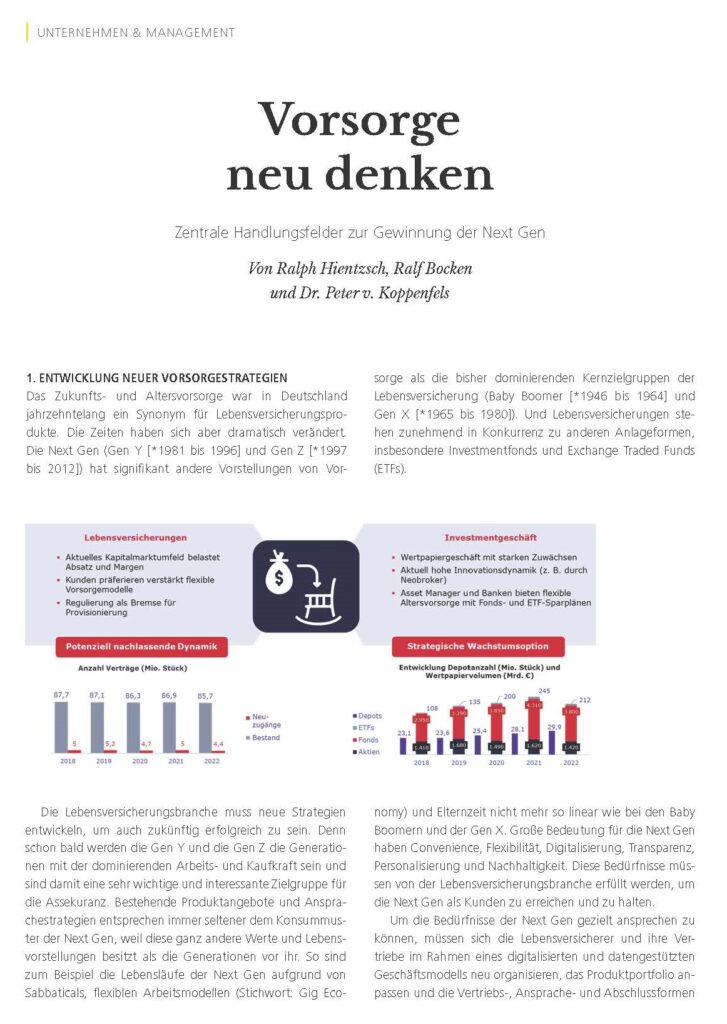Central fields of action for winning the Next Gen
1. Development of new pension strategies
The future and old-age provision was synonymous with life insurance products in Germany for decades. Times have changed dramatically, however. The Next Gen (Gen Y [1981 to 1996] and Gen Z [1997 to 2012]) has significantly different ideas of provision than the previously dominant core target groups of life insurance (Baby Boomers [1946 to 1964] and Gen X [1965 to 1980]). And life insurance is increasingly competing with other forms of investment, especially investment funds and exchange-traded funds (ETFs).
The life insurance industry must develop new strategies in order to remain successful in the future. Because Gen Y and Gen Z will soon be the generations with the dominant working and purchasing power and are thus a very important and interesting target group for the insurance industry. Existing product offers and address strategies correspond less and less to the consumption pattern of the Next Gen, because they have completely different values and ideas about life than the generations before them. For example, due to sabbaticals, flexible working models (keyword: gig economy) and parental leave, the life courses of the Next Gen are no longer as linear as those of the Baby Boomers and Gen X. Convenience, flexibility, digitalisation, transparency, personalisation and sustainability are of great importance for the Next Gen. These needs must be met by the life insurance industry in order to reach and retain the Next Gen as customers.
In order to be able to address the needs of the Next Gen in a targeted manner, life insurers and their sales organisations must reorganise themselves within the framework of a digitalised and data-supported business model, adapt the product portfolio and modernise the forms of distribution, approach and conclusion. It is about a new customer experience and more proximity to the customer (see also “Closer to the customer”, Versicherungswirtschaft 07.2020, 75th Jg., pp. 24-27). Insurers that score points with the Next Gen will be those that offer customised products and services based on individual customer information and sales access.
2. Rethinking provision, central fields of action
From Consileon’s project experience, four central fields of action emerge with which life insurers can reach the Next Gen in the area of pension provision and grow:
Digitalisation and AI-supported data analytics
The Next Gen prefers to interact digitally, which means that the amount and quality of available information and data is increasing significantly. In return, the Next Gen expects individually tailored and personalised product and solution offerings based on this data. For the insurance industry, digitalisation, AI-supported data analytics and customer excellence are crucial for the sales use of the collected data with the Next Gen. In our experience, this is the only way to win the members of the Next Gen as pension customers (see also “The future begins today”, Versicherungswirtschaft 11.2022, 77th Jg., pp. 52-53). A best practice example of this is Zurich Group Germany, which uses data analytics to provide its customers with product offers that are precisely tailored and personalised to their needs.
Important for the digitalisation of touchpoints with the Next Gen is the digital activation of the customer, i.e. obtaining the customer’s declaration of consent (EWE) for digital interaction (also opt-in). This is essential in order to be allowed to communicate digitally with customers (keyword: DSGVO). Project practice at various top 10 insurers shows: a rapid increase in the consent rate can be achieved with consistent implementation management and is not rocket science.
Digital networking of all business and sales processes
To enhance the customer experience of the Next Gen, it is also necessary to further develop the business, service and sales processes. The Next Gen is used to digital forms of consultation and conclusion from other industries and has come to appreciate them for their convenience and flexibility. Therefore, they also expect these digital approaches from life insurers – as well as the possibility to change channels (digital and analogue) depending on the situation.
If insurers want to convince the Next Gen of their pension products, then advice and sales must be flexible and convenient. In concrete terms, comprehensive digital forms of sales and support should be created that are closely and effectively interlinked with the existing analogue forms of sales and support (so-called hybrid support or hybrid sales). Furthermore, processes should be digitalised and automated as much as possible. In this way, the next generation can be served according to their needs without neglecting the existing customer groups. Ergo, for example, has masterfully implemented this with the introduction of the “hybrid business model”.
Automated lead management
The Next Gen expect individualised digital communication combined with personalised pension offers. Insurers can meet this expectation with automated lead management. This involves automatically generated, event-driven and individualised digital messages to customers (e.g. emails or push notifications). These contain a personalised pension offer for the customer (Next Best Offer) based on their individual pension situation in combination with digital closing and response options (callback button, linking to websites, chat, etc.).
With effective lead management, sales can be significantly increased, especially through cross-selling in the customer base. Good examples of best practice are Baloise and Helvetia, which use these tools very successfully to address customers in sales.
Flexible, needs-based and sustainable pension product portfolio
The need for old-age provision and protection against life risks (especially longevity) is also high among the Next Gen. And the importance of private provision is increasing with the growing flexibilisation of work models. In particular, the increasing digitalisation of the world of work and the expansion of the gig economy are giving rise to new forms of work with new pension needs. Furthermore, in addition to sustainable products and price and cost transparency, the Next Gen expects a high degree of flexibility in the savings and payout phase due to the long-term nature of pension contracts.
The insurance industry needs simple, comprehensible pension and investment concepts in which customers can pay in and out flexibly and change the investment structure online independently if necessary. Ideally, the flexibility of funds and ETFs is combined with the security of life insurance. To create transparency, Next Gen members should always be informed online or mobile about the status, development and composition of their pension solution. A small number of insurers already have very promising digital and flexible product offerings on the market. Best practices include Allianz with its flexible and fully digital retirement provision Fourmore and R+V with the AnsparKombi Safe+Smart.
Last, but not least, a comprehensive range of sustainable pension solutions is needed to convince the Next Gen. Without a product portfolio geared towards sustainability and ecologically and socially correct behaviour, life insurers will only realise limited growth with the Next Gen (see also “A greener positioning is not to be had for free”, Versicherungswirtschaft 09.2022, 77th Jg., pp. 84-87). A few insurers have taken up the topic and consistently offer sustainable pension solutions. A pioneer, for example, is Pangaea Life plusrente from Bayerische with its investment in renewable energies and sustainable real estate. Analyses by Consileon show an ever-growing spectrum of impact investing opportunities. These will also have greater relevance in the investment of insurers, in addition to on the customer side.
3. Outlook
Life insurers must consistently rethink pension provision and meet the demands of the Next Gen for convenience, flexibility, digitalisation, transparency, personalisation and sustainability. Only then will they be able to maintain and gain market share. The fields of action outlined here are central keys to the success of insurers in the pension market of the future.
Best practice examples show that some insurers are already completely reorienting and redesigning their pension business to create the necessary customer experience. We assume that by 2030 only a small number of life insurers will successfully operate the pension business nationally. Based on Consileon analyses, in addition to the necessary realignment of the business field, the management KPIs for the pension business will also change dynamically.
You can find out more in this month’s article from the insurance industry, which you can download as an offprint here (article is in German).




